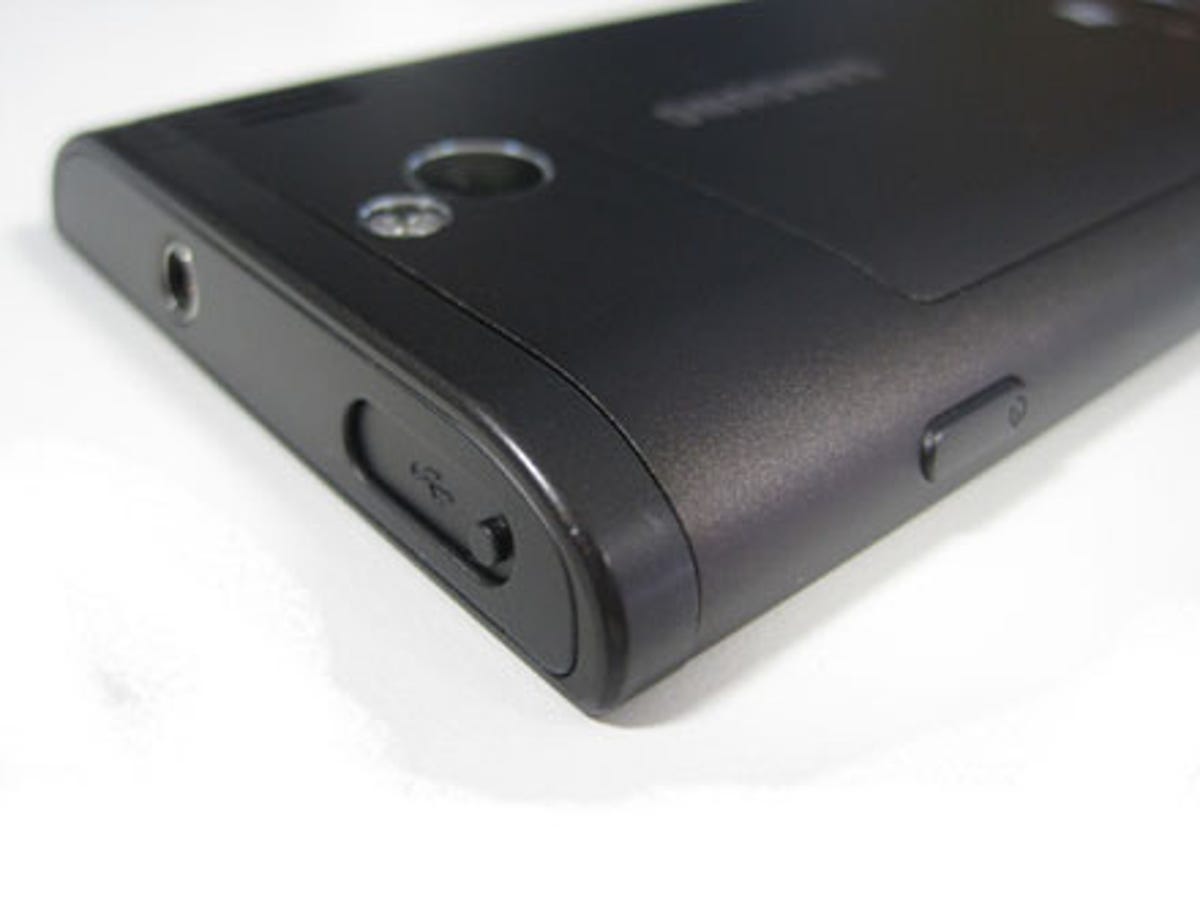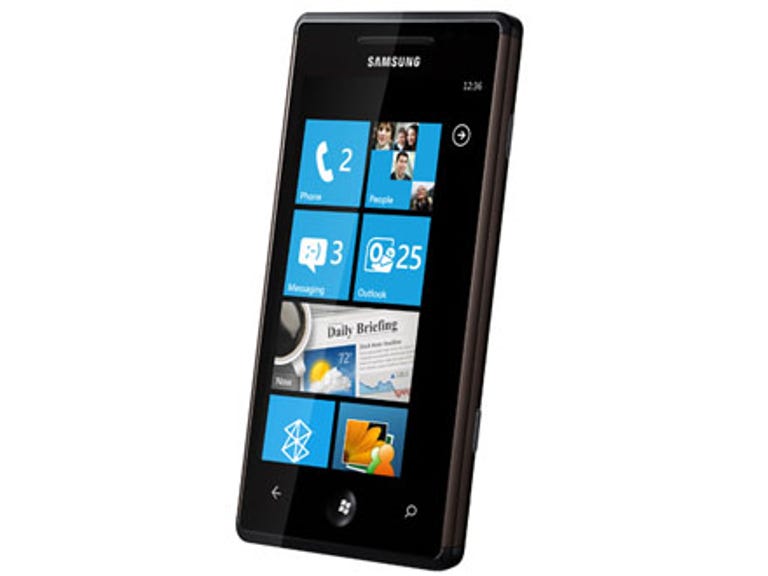 Why You Can Trust CNET
Why You Can Trust CNET Samsung Omnia 7 GT-i8700 review: Samsung Omnia 7 GT-i8700
The Samsung Omnia 7 is a neat bit of kit, with its large super AMOLED screen and nippy processor, and should do the Windows Phone 7 OS justice. We just wish there was more to make this mobile stand out from the herd of competing devices.
Boasting Microsoft's new Windows Phone 7 operating system and a vibrant AMOLED screen nabbed rather cheekily from the Galaxy S, the Samsung Omnia 7 means business. That said, some curious hardware design choices and the emptiness of the Windows Phone Marketplace slightly undermine what is otherwise a highly favourable debut for the Korean manufacturer.
The Good
The Bad
The Bottom Line
The Samsung Omnia 7 is available on contract from approximately £35 per month and SIM-free for around £500.
Looks to kill
Following months of hype and expectation, the Windows Phone onslaught has begun in earnest. We've already seen the LG Optimus 7 and HTC HD7, and now it's Samsung's turn to dip its toes into the rippling waters of this new and exciting OS. The Omnia 7 is unmistakably a high-level device, intended to dazzle users with its combination of cutting-edge hardware and sleek design.
Like its Android-packing stablemate the Galaxy S, the Omnia 7's front display is absolutely dominated by its whopping 4-inch Super AMOLED screen, with a pin-sharp pixel resolution of 800x480. Although it's a phrase that is bandied about a little too readily these days, we have to say, this display has to be seen to be believed. Granted, it's a smidgen smaller than the HTC HD7's muscular 4.3-inch screen, but in terms of quality, the difference between LCD and Super AMOLED is like night and day.
In fact, much of the visual impact made by the Omnia 7 is down to its brilliant display. It really makes the intuitive Windows Phone user interface come to life, with bold colours, stunning contrast and striking brightness. Images are crystal-clear, and viewing photos you've taken is a genuinely enjoyable experience. Unlike the HD7, the screen dimensions may not tiptoe dangerously close to tablet territory, but we'd gladly take quality over size in this particular scenario.
A real handful
Naturally, a large screen begets an equally imposing frame, and the Omnia 7 follows the trend set by the Galaxy S and HTC Desire HD for hand-crampingly large handsets. Although the bodywork is surprisingly thin at just 11mm, it fills your palm with its massive footprint.
It's not the most comfortable phone to use, however. When you're holding the device with one hand and attempting to interact with items at the top of the screen with your thumb, things can become rather awkward. It's not a massive issue -- and to be fair, the days of one-handed phone use are well and truly over thanks to this incoming wave of pocket behemoths -- but we've certainly cradled more accommodating devices in our eager palms.
We're losing power
Another design concern is thrown up by the puzzlingly illogical placement of the Omnia 7's power button. Rather than put it on the top of the phone, Samsung has opted to shove it on the right-hand side, directly above the camera button.
A similar arrangement can be found on the Galaxy S, but the key difference between the two Samsung siblings is that the Omnia 7's power button is more pronounced, and sticks out from the casing, making it far too easy to inadvertently press.

This wouldn't be an issue if Samsung ensured the power button was deactivated whenever the phone was locked and in your pocket, but, sadly, this isn't the case. Even when the phone is idling and the screen is blank, holding down the power key for a prolonged period switches the whole device off. During our review period, we experienced several unintentional in-pocket power-downs. The location of the button could just as easily result in accidental shut-downs during normal use or -- even worse -- amid a phone conversation.
Looking past this design-related blunder, there's no denying that the Omnia 7 is an attractive slab of technology. The glossy, iPhone 3G-like exterior of the Galaxy S has been forsaken for a reassuring matte finish, which should ensure your expensive new toy doesn't slip out of your sweaty palm and fall onto cold, unsympathetic concrete during vigorous use.
Capture the moment
Digging deeper into the Omnia 7's exterior, we find a 5-megapixel camera with 720p video-recording and an LED flash. Although Samsung's device loses out to the 8-megapixel HTC Mozart in the numbers game, the quality of the photographs and videos produced by the Omnia 7 is remarkable. Everything is deliciously clear and crisp, and the camera is able to capture a wide range of colours -- as evidenced when you gawp at the results on that gorgeous AMOLED screen.
In a move that possibly acknowledges Microsoft's somewhat unusual policy on external storage (SD cards are supported within the OS, but removing an SD card from a Windows Phone factory mobile resets the device), the Omnia 7 lacks any kind of expandable memory. It comes in 8GB and 16GB flavours, which is worth bearing in mind if you're looking for a place to store your humungous MP3 collection. While Microsoft's stance on external storage is in line with Apple's, the lack of a 32GB variant in the Omnia 7 stable may dampen the enthusiasm of serial data hoarders.
In terms of software, we've already covered the ins and outs of Windows Phone 7 in our extensive review of the new OS. Suffice to say, the Omnia 7's lustrous screen adds immeasurably to the experience. Because manufacturers aren't allowed to tinker around with the inner workings of the user interface too eagerly, the general menu structure is consistent across all Windows Phone handsets. While this neatly avoids the fragmentation nightmare that currently afflicts the Android range of phones -- with different companies possessing their own unique flavour of the OS, which slows down Google's incremental update process -- it results in devices that lack unique features and identity.
The here and now
Pre-installed exclusive applications are the only way Windows Phone manufacturers can differentiate their products from those of their rivals, and in the case of the Omnia 7, Samsung has included a few of its own choice cuts. The most notable is Now, which functions in very much the same way as the News & Weather widget on Google's stock Android platform. Here you can browse the latest global news stories, check out the weather and see what's occurring on the stock markets.
Like the other Windows Phones we've covered, getting online with the Omnia 7 is a real joy. Being a top-level device, it naturally supports Wi-Fi data connectivity, and the nippy 1GHz Snapdragon processor allows the phone to load up even the most image-heavy webpage in a heartbeat. Even when compared to a Nexus One running the latest version of Google's Android platform, the performance is incredible. Serious Web surfers will be pleased to know that pinch-to-zoom is also supported, but they'll grumble at the fact that Adobe Flash currently isn't.
Elsewhere, Windows Phone's usual suite of default applications is all present and correct. Zune music player functionality will be an absolute boon for audiophiles, and the overall experience certainly puts Apple's iPod and iPhone to shame. Gamers will revel in the Xbox Live feature, but, sadly, there are very few titles available that are actually worth playing.
The same story goes for apps, although it has to be remembered that it's very early days yet and this situation is changing on a weekly basis. Very recently, the official Windows Phone Twitter app was launched. Looking beyond Christmas -- when Microsoft and its partners are sure to shift plenty of units at retail -- we can see a real explosion of content in this area. Despite this positive outlook, if you're looking for a device that is heavily supported in terms of games and applications from day one of purchase, you're probably better off throwing your lot in with either Apple or Android. Both already have digital marketplaces packed with thousands of downloadable programs.
Conclusion
While HTC has unleashed three different Windows Phone devices onto the market and LG has two, Samsung has put all of its eggs into one basket with the Omnia 7. In terms of software, there's very little to choose between all of the available phones, as they all operate in very much the same way. The Omnia 7 loses points for its bizarrely located power button, but it makes up for this quirk with a glorious Super AMOLED screen, an excellent 5-megapixel camera and an aesthetically pleasing appearance.
Windows Phone clearly has a long way to go, and this first wave of products will undoubtedly be improved upon. In the meantime, if you've a burning desire to join Microsoft's mobile revolution, it's a very close race between the Omnia 7 and HTC's HD7.
Edited by Emma Bayly


